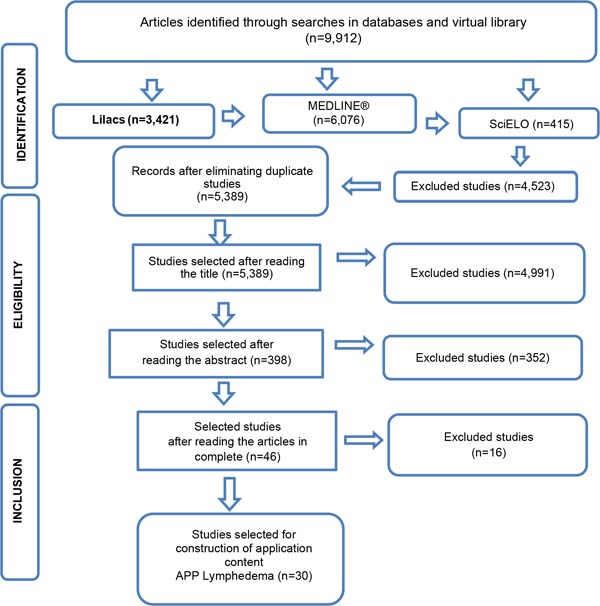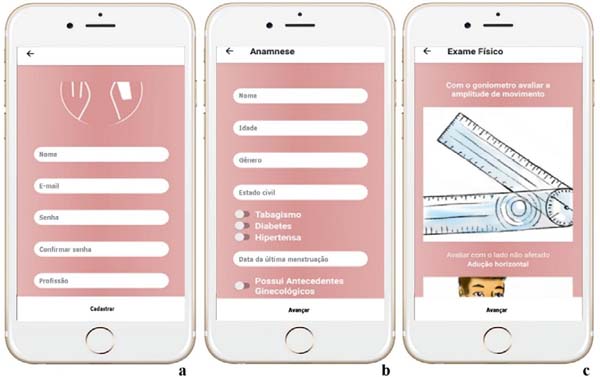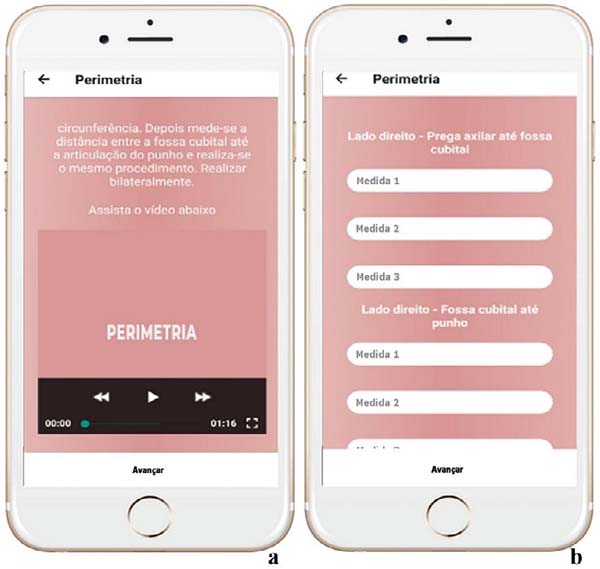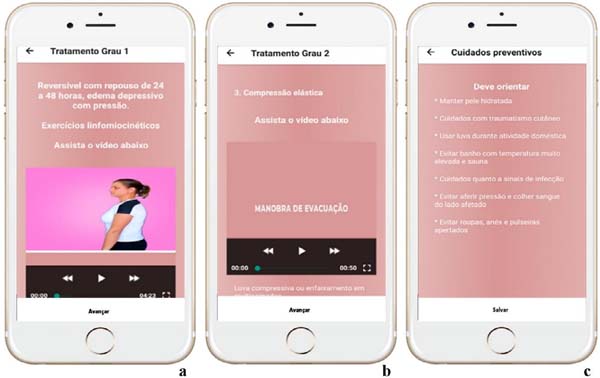

Original Article - Year 2023 - Volume 38 -
Upper limb lymphedema treatment application
Aplicativo para tratamento do linfedema de membros superiores
ABSTRACT
Introduction: Secondary lymphedema commonly develops due to trauma to the lymphatic system, and may occur after cancer surgery. The mobile application is an easily accessible and low-cost means of technical-scientific updating that can help the health professional to provide the best treatment for the patient. Thus, the objective of this study was to build an application for the treatment and prevention of upper limb lymphedema.
Methods: The construction of the application took place in four stages: (1) Conception, involving the identification of application development needs; Content development, including an integrative literature review in the main databases; (3) Construction, consisting of structuring the database and developing the software; and (4) Transition, comprising carrying out functionality tests.
Results: The developed application (Linfedema APP) consists of 31 screens, 4 figures and 3 videos. It was registered at the National Institute of Industrial Property (INPI) of the Ministry of Development, Industry and Foreign Trade, and is available for free on the Google Play Store.
Conclusion: After an integrative review of the literature in the main databases, the "Lymphedema APP" application was developed, which constitutes a practical tool to qualify, direct and guide the physiotherapist in performing the exercises in post-mastectomized patients with lymphedema in the upper limbs.
Keywords: Lymphedema; Clinical protocols; Physical therapy modalities; Mobile applications; Breast cancer lymphedema
RESUMO
Introdução: O linfedema secundário se desenvolve comumente devido a um trauma no sistema
linfático, podendo ocorrer após cirurgia de câncer. O aplicativo móvel é um
meio de atualização técnico-científica de fácil acesso e de baixo custo que
pode auxiliar o profissional de saúde a proporcionar o melhor tratamento
para o paciente. O objetivo desse estudo foi construir um aplicativo para
tratamento de linfedema de membros superiores.
Método: A construção do aplicativo ocorreu em quatro etapas: (1) Concepção,
envolvendo a identificação das necessidades do desenvolvimento do
aplicativo; (2) Elaboração do conteúdo, incluindo a revisão integrativa da
literatura nas principais bases de dados; (3) Construção, consistindo na
estruturação do banco de dados e desenvolvimento do
software; e (4) Transição, compreendendo a realização
de testes de funcionalidade.
Resultados: O aplicativo desenvolvido (Linfedema APP) é composto por 31 telas, 4 figuras
e 3 vídeos. Ele foi registrado no Instituto Nacional da Propriedade
Industrial (INPI) do Ministério do Desenvolvimento, Indústria e Comércio
Exterior e está disponível gratuitamente na Google Play Store.
Conclusão: Após a revisão integrativa da literatura nas principais bases de dados, foi
desenvolvido o aplicativo "Linfedema APP", o qual se constitui em ferramenta
prática para qualificar, direcionar e guiar o fisioterapeuta na realização
dos exercícios nas pacientes pósmastectomizados com linfedema em membros
superiores.
Palavras-chave: Linfedema; Protocolos clínicos; Modalidades de fisioterapia; Aplicativos móveis; Linfedema relacionado a câncer de mama
INTRODUCTION
Lymphedema is one of the relevant complications that occur in the postoperative period of patients undergoing a surgical procedure for the treatment of cancer, resulting from the concentration of fluid in the interstitium, with a large protein cluster motivated by disorders of the lymphatic circulation that affects, above all, the upper limbs1. Lymphedema in post-mastectomy patients occurs in around 20% to 30% of cases, with a prevalence rate of 15% to 30%1-3.
Patients who undergo mastectomy must be treated postoperatively by a physiotherapist. This professional aims to control postoperative pain, prevent or treat lymphedema and postural changes, promote muscle relaxation, maintain the range of motion of the upper limb involved, and improve the appearance and malleability of the scar, preventing or treating adhesions1,4. One of the physiotherapist’s interventions is complex decongestive therapy, which consists of four approaches: guidance on skin care, manual lymphatic drainage, compressive bandaging, and lymphomyokinetic exercises - all to reduce lymphedema2-4.
For the physiotherapist to provide guidance, it is necessary to have technical-scientific knowledge and to develop educational resources and technologies (applications, electronic games, online courses, electronic medical records) with low cost, greater effectiveness, ease, and accessibility to the population5,6.
Several studies have shown that applications have been developed to provide care and guide clinical decisions. These are validated studies and results of research-based recommendations for practice5-7. Building an app for mobile devices offers professionals, caregivers, and patients a quick way to consult. It is easily transported to the various practice settings in healthcare facilities. It is hoped that doubts are resolved when accessing this tool and that there is more autonomy, both in the execution of physiotherapy exercises and in the control of clinical evolution8-14.
Developing an application aimed at post-mastectomized patients with upper limb lymphedema (UL) is unprecedented in Physiotherapy. It is an approach of great scientific and social relevance insofar as it provides accessibility to specific forms of care and ensures easy access to information and control of patients’ evolution. The developed application is evident as a new therapeutic path in the area of rehabilitation of mastectomized patients.
OBJECTIVE
Therefore, this study aimed to build an application for preventing and treating upper limb lymphedema.
METHODS
The study applied the technological production modality of the methodological development research type to construct an application for the prevention and treatment of UL lymphedema in post-mastectomized patients, entitled ”Linfedema APP.”
As an application development methodology, Contextualized Instructional Design (CID) was chosen, which involves a constructivist proposal and consists of the intentional action of planning, developing, and applying specific didactic situations, incorporating mechanisms that favor contextualization15.
The construction of the application took place in four stages, including conception, elaboration of the content, construction of the application, and performance of functionality tests.
The study design involved understanding the educational problem and devising a related solution. A previous search was carried out to verify the existence of applications that guide the physiotherapist in evaluating, preventing, and treating upper limb lymphedema in post-mastectomized patients.
After verifying the problem’s existence, an integrative literature review was carried out in the Health Sciences databases, including the Cochrane Library, SciELO, LILACS, and MEDLINE, using as descriptors lymphedema and physiotherapy.
For the selection of publications to be included in the review, two basic axes were adopted as inclusion criteria: only primary studies that were directly linked to the theme to be available in full and without proposed temporal delimitation, as the intention was to compile all studies that met the established criteria. Book chapters, theses, dissertations, monographs, technical reports, reference works, and articles that, after reading the abstract, did not converge with the proposed object of study, and publications that were repeated in the databases and virtual library were excluded.
After reading the abstracts, articles that described the descriptors lymphedema and physiotherapy were selected. Based on this survey, an application was created to treat and prevent post-mastectomized patients with upper limb lymphedema (Figure 1 and Chart 1).
| Author | Title | Periodic.
Year; Volume (Number): Page |
|---|---|---|
| Howell DM, et al. | Complete decongestive therapy for lymphedema following breast cancer treatment (Protocol). | Cochrane Database Syst Rev. 2009 |
| Carvalho APF & Azevedo EMM | Estudo comparativo entre a fisioterapia aquática e a convencional para reduzir linfedema pós-tratamento cirúrgico de câncer de mama: ensaio clínico randomizado / Comparative study between the aquatic physiotherapy and the conventional for lymphedema reduction after surgical treatment for breast cancer: randomized clinical trial | Rev Bras Mastologia. 2009;19(4):133-40 |
| Forner-Cordero I, et al. | Predictive Factors of Response to Decongestive Therapy in Patients with Breast-Cancer-Related Lymphedem | Ann Surg Oncol. 2010;17(3):744-51 |
| Soares HPS, et al. | Complex decongestant therapy with use of alternative material to reduce and control lymphedema in patients with endemic area of filariasis: a clinical trial | Fisioter Pesqui. 2016;23(3):268-77 |
| Kim DS, et al. | Effect of active resistive exercise on breast cancer-related lymphedema: a randomized controlled trial | Arch Phys Med Rehabil. 2010;91(12):1844-8 |
| Hacard F, et al. | Measurement of skin thickness and skin elasticity to evaluate the effectiveness of intensive decongestive treatment in patients with lymphoedema: a prospective study | Skin Res Technol. 2014;20(3):274-81 |
| Kasseroller RG & Brenner E | A prospective randomised study of alginate-drenched low stretch bandages as an alternative to conventional lymphologic compression bandaging | Support Care Cancer. 2010;18(3):343-50 |
| Karafa M, et al. | The effect of different compression pressure in therapy of secondary upper extremity lymphedema in women after breast cancer surgery | Lymphology. 2018;51(1):28-37 |
| Melam GR, et al. | Effect of complete decongestive therapy and home program on healthrelated quality of life in post mastectomy lymphedema patients | BMC Womens Health. 2016;16(1):16-23 |
| Bozkurt M, et al. | Effectiveness of Decongestive Lymphatic Therapy in Patients with Lymphedema Resulting from Breast Cancer Treatment Regardless of Previous Lymphedema Treatment | Breast J. 2017;23(2):154-8 |
| Tambour M, et al. | Manual lymphatic drainage adds no further volume reduction to Complete Decongestive Therapy on breast cancer-related lymphoedema: a multicentre, randomised, single-blind trial | Br J Cancer. 2018;119(1):1215-22 |
| Melgaard D | What is the effect of treating secondary lymphedema after breast cancer with complete decongestive physiotherapy when the bandage is replaced with Kinesio Textape? - A pilot study | Physiother Theory Pract. 2016;32(6):446-51 |
| Dayes IS, et al. | Randomized Trial of Decongestive Lymphatic Therapy for the Treatment of Lymphedema in Women With Breast Cancer | J Clin Oncol. 2013;31(30):3758-63 |
| Park JH | The effects of complex exercise on shoulder range of motion and pain for women with breast cancer-related lymphedema: a single-blind, randomized controlled trial | Breast Cancer. 2017;24(4):608-14 |
| Oliveira MMF, et al. | Long term effects of manual lymphatic drainage and active exercises on physical morbidities, lymphoscintigraphy parameters and lymphedema formation in patients operated due to breast cancer: a clinical trial | PLoS One. 2018;13(1):e0189176 |
| Haghighat S, et al. | Comparing two treatment methods for post mastectomy lymphedema: complex decongestive therapy alone and in combination with intermittent pneumatic compression | Lymphology. 2010;43(1):25-33 |
| Gatt M, et al. | A meta-analysis of the effectiveness and safety of kinesiology taping in the management of cancer-related lymphoedema | Eur J Cancer Care (Engl). 2017;26(5):1-13 |
| Uzkeser H, et al. | Efficacy of manual lymphatic drainage and intermittent pneumatic compression pump use in the treatment of lymphedema after mastectomy: a randomized controlled trial | Breast Cancer. 2015;22(3):300-7 |
| Mestre S, et al. | Interest of an auto-adjustable nighttime compression sleeve (MOBIDERM® Autofit) in maintenance phase of upper limb lymphedema: the MARILYN pilot RC | Support Care Cancer. 2017;25(8):2455-62 |
| Kizil R, et al. | Is Continuous Passive Motion Effective in Patients with Lymphedema? A Randomized Controlled Trial | Lymphat Res Biol. 2018;16(3):263-9 |
| Szoinoky G, et al. | Intermittent pneumatic compression acts synergistically with manual lymphatic drainage in complex decongestive physiotherapy for breast cancer treatment-related lymphedema | Lymphology. 2009;42(4):188-94 |
| Cacchio A, et al. | Effectiveness and safety of a product containing diosmin, coumarin, and arbutin (Linfadren®) in addition to complex decongestive therapy on management of breast cancer-related lymphedema | Support Care Cancer. 2019;27(4):1471-80 |
| Gradalski T, et al. | Complex Decongestive Lymphatic Therapy With or Without Vodder II Manual Lymph Drainage in More Severe Chronic Postmastectomy Upper Limb Lymphedema: A Randomized Non-Inferiority Prospective Study | J Pain Symptom Manage. 2015;50(6):750-7 |
| Do JH, et al. | Effects of a complex rehabilitation program on edema status, physical function, and quality of life in lower-limb lymphedema after gynecological cancer surgery | Gynecol Oncol. 2017;147(2):450-5 |
| Abbasi B, et al. | The effect of relaxation techniques on edema, anxiety and depression in post-mastectomy lymphedema patients undergoing comprehensive decongestive therapy: A clinical trial | PLoS One. 2018;13(1):e0190231 |
| Ergin G, et al. | Effects of Aqua-Lymphatic Therapy on Lower Extremity Lymphedema: A Randomized Controlled Study | Res Biol. 2017;15(3):284-91 |
| Vignes S, et al. | Intensive complete decongestive physiotherapy for cancer-related upper-limb lymphedema: 11 days achieved greater volume reduction than 4 | Gynecol Oncol. 2013;131(1):127-30 |
| Pekyavaş NÖ, et al. | Complex decongestive therapy and taping for patients with postmastectomy lymphedema: A randomized controlled study | Eur J Oncol Nurs. 2014;18(6):585-90 |
| Bok SK, et al. | Ultrasonographic Evaluation of the Effects of Progressive Resistive Exercise in Breast Cancer-Related Lymphedem | Lymphat Res Biol. 2016;14(1):18-24 |
| Ha KJ, et al. | Synergistic effects of proprioceptive neuromuscular facilitation and manual lymphatic drainage in patients with mastectomy-related lymphedema | Front Physiol. 2017;8:959 |
| Vakharia PP, et al. | Bibliometric analysis of breast cancer-related
lymphoedema research published from 2007-2016 |
J Lymphoedema. 2017;12(1):16-8 |
| Samuel SR, et al. | Exercise-based interventions for cancer survivors in India: a systematic review | Springerplus. 2015;4(1):655 |
| Nicholson R, et al. | Understanding the acceptability and feasibility of a regional Lymphoedema surveillance programme: a pilot study | J Lymphoedema. 2019;14(1):32-6 |
The planning and production of didactic content included the definition of topics and the writing of subjects. For the construction of the application, the media were selected, as well as the design of the interface (layout). We opted for using texts, illustrations, and videos structured in topics and connected by hypertexts (links). The navigation structure was defined, and the environment configuration was planned.
The tools, educational, and technological resources were configured, as well as the construction of an environment to download the application on the Internet and install it on the mobile device.
Then, functionality tests were carried out (usability, performance, compatibility, and functionality). The testing process was carried out according to the steps described below:
• Usability testing: to verify that the user can intuitively use the application from the home screen to the final result. The project’s authors used the application five times, registering the patient and verifying the physiotherapeutic treatment procedures in the patient with lymphedema.
• Performance test: The responsiveness after each command performed was evaluated. During the use of the application, the systems analyst and the project authors checked the initialization time, screen changes, and application completion time. The access time to each screen, the time to register a new patient, and the reading of the physiotherapy treatment procedure were considered.
• The compatibility test with the theoretical framework was divided into two phases. First, the test verified information at the semantic and syntactic level of the application’s content. In the second phase, functional or black-box testing was used to test the system. The systems analyst conducted this test.
For the functional test of the application, some devices were chosen that had Android technology as determinants, characterized by mobile equipment and with WiFi connectivity available for access to the wireless network to carry out the usability and compatibility tests. The authors and the systems analyst conducted the entire testing process.
RESULTS
The application consists of 31 screens, 4 pictures, and 3 videos. The initial screen contains ” Enter ” icons for registered users or ”Register” for new ones. When completing the registration (Figure 2a), the user will open the anamnesis screen by clicking ”Next” (Figure 2b). After completing the anamnesis, the user will be directed to the physical examination screen (Figure 2c), where he can assess the range of motion with illustrations and instructions on performing the measurement technique.
Clicking ”Next” will open the perimetry screen for the patient with UL lymphedema. After viewing the demonstrative video of the perimetry technique (Figure 3a), the user can fill in the data collected in the form fields (Figure 3b) according to the height and segment of the affected limb.
After carrying out the anamnesis, physical examination, and perimetry, and depending on the results obtained and the characteristics of the skin, the user will be automatically directed to the treatment indications according to the degree of clinical staging of the lymphedema (Figure 4). The application offers therapeutic management options for post-mastectomized patients with MMS lymphedema and indicates preventive care (Figure 4a, b, and c).
The application was registered at the National Institute of Industrial Property (INPI) of the Ministry of Development, Industry, and Foreign Trade and is available on the Google Play Store under the name ”Linfedema APP.”
DISCUSSION
The choice of theme for the ”Linfedema APP” application arose because of the difficulties observed by researchers during their clinical practices, in the sense that some professionals have difficulty in assessing, prescribing preventive measures and therapeutic management for post-mastectomized patients with upper limb lymphedema. A previous search was then carried out, which showed that no application helps or guides the physiotherapist in an evaluation. Because of this fact, it was decided to develop the ”Linfedema APP” application, which, after evaluating the patient, will provide professionals with indications of preventive measures and physiotherapeutic exercises.
In Brazil, the use of management software has grown exponentially in different areas. In the work process of health professionals, information technology is increasingly improving through the development and evaluation of tools, processes, and structures that help these professionals manage care, whether preventive or therapeutic7,16-18.
Professionals who deal with post-mastectomized patients with upper limb lymphedema, when using the application developed in this study, will be acquiring and developing clinical skills, as they will assist with the lowest possible risk, without damage and adverse events, in short, assistance with security for post-mastectomized individuals, since this technological instrument was developed with a scientific basis, through an integrative review of the literature found in the main databases.
The more clinical information an application provides, the better the decision-making process. Thus, it is essential to develop technological tools that make clinical management related to people with post-mastectomy lymphedema more efficient and minimize the difficulties and deficiencies of health professionals in clinical practice5,19.
The ”Linfedema APP” application allows physiotherapists, through smartphones, notebooks, and tablets, quick access to information during the consultation and clinical evaluation, helping the professional collect data, as the application provides a report of the entire evaluation and procedures performed. It also provides videos demonstrating the technique of physiotherapeutic exercises.
An application must have a social impact, offer health professionals theoretical and practical foundations, as well as standardization of assessment, preventive measures, therapeutic approaches, and instructions for self-care, which result in improved care provided to patients, individualized and systematized care, greater safety for health professionals and patients5,12,20.
With technological advances, mainly in telephone devices, the use of applications is becoming more and more common; in this way, professionals will make more informed decisions, following clinical protocols that will be evolutionarily more effective, providing less chance of error during the clinical procedure12,20.
CONCLUSION
After an integrative review of the literature in the main databases, the ”Linfedema APP” application was developed, which constitutes a practical tool to qualify, direct, and guide the physiotherapist in performing the exercises in post-mastectomized patients with lymphedema in the upper limbs.
1. Universidade do Vale do Sapucaí, Pouso Alegre,
MG, Brazil
Corresponding author: Geraldo Magela Salomé Av. Prefeito Tuany Toledo, 470, Pouso Alegre, MG, Brazil., Zip Code: 37550-000., E-mail: salomereiki@univas.edu.br












 Read in Portuguese
Read in Portuguese
 Read in English
Read in English
 PDF PT
PDF PT
 Print
Print
 Send this article by email
Send this article by email
 How to Cite
How to Cite
 Mendeley
Mendeley
 Pocket
Pocket
 Twitter
Twitter